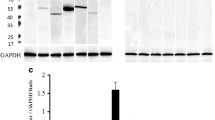Summary
Freeze-fractured preparations (with and without etching procedures) of guineapig and rat thyroid (C-) cells and anterior pituitary (somatotropic-) cells have been investigated with the electron microscope. The hormone granules of these cells in general split either between the two lamellae of their unit membrane or between the granule contents and the unit membrane. Only rarely cross-broken granules have been observed. Inner and outer lamella of the unit membrane of the C-cell granules contain in more or less similar frequency moderate amounts of protein particles of 100–200 Å diameter. In case of the somatotrophs the outer lamella contains higher numbers of these particles than the inner one. The contents of the C-cell and somatotroph granules seems to consist of densely packed 80–100 Å particles. A particular zone between contents and membrane (as observed on micrographs with conventional electron microscopy) could not be detected on freeze-fractured preparations. The etching procedure does not reveal additional details of the granule structure.
A size distribution curve of the C-cell granules as determined from stereo-pairs, is given.
Zusammenfassung
Gefriergebrochene Präparate (mit und ohne Ätzung) der Adenohypophyse und der C-Zellen der Schilddrüse von Ratte und Meerschweinchen wurden elektronenmikroskopisch untersucht. Bei den Hormongranula dieser Zellen verlaufen die Bruchflächen im allgemeinen zwischen den beiden Membranflächen oder zwischen Granulum-Inhalt und Membran. Nur relativ selten werden Granula quergebrochen. Auf beiden Hälften der gespaltenen Membranen der C-Zellgranula werden etwa mit gleicher Häufigkeit Proteinpartikel (100–200 Å) gefunden. Bei den Granula der somatotropen Zellen treten auf der dem Plasma anliegenden Membranhälfte deutlich mehr Proteinpartikel auf als auf der dem Granuluminhalt anliegenden Hälfte. Der Inhalt der somatotropen und C-Zellgranula erscheint bei dieser Präparationsmethode aus einer dichten Packung von 80–100 Å großen Partikeln zu bestehen.
Eine besonders strukturierte Zone zwischen Membran und Granuluminhalt konnte bei den bisherigen Untersuchungen nicht festgestellt werden. Durch Ätzung der Gefrierbrüche ließen sich keine zusätzlichen strukturellen Details der Granula darstellen.
Eine durch Auswertung von stereoskopischen Aufnahmen gewonnene Größenverteilungskurve für die C-Zellgranula wird vorgelegt.
Similar content being viewed by others
Literatur
Bargmann, W., Gaudecker, B. v.: Über die Ultrastruktur neurosekretorischer Elementargranula. Z. Zellforsch.96, 495–504 (1969).
Branton, D.: Fracture faces of frozen membranes. Proc. nat. Acad. Sci. (Wash.)55, 1048–1056 (1966).
Farquhar, M. G.: Processing of secretory products by cells of the anterior pituitary gland. Mem. Soc. Endocrin.19, 79–124 (1971).
Forssmann, W. G.: Ultrastructure of hormone producing cells of the upper gastrointestinal tract. In: Origin, chemistry, physiology and pathophysiology of the gastrointestinal hormones, ed. by W. Creutzfeld. Stuttgart-New York: F. K. Schattauer 1970.
Lange, R.: Licht- und elektronenmikroskopische Identifizierung der Zelltypen im Inselapparat des Frosches,Rana ridibunda. Z. Zellforsch.82, 156–172 (1967).
Livingston, A., Lederis, K.: Functional ultrastructure of the neurohypophysis. Mem. Soc. Endocrin.19, 233–262 (1971).
Meyer, H. W., Winkelmann, H.: Die Gefrierätzung und die Struktur biologischer Membranen. Protoplasma (Wien)68, 253–270 (1969).
Moor, H., Mühlethaler, K.: Fine structure in frozen-etched yeast cells. J. Cell Biol.17, 609–628 (1963).
Nunez, E. A., Gould, R. P., Hamilton, D. W., Hayward, J. S., Holt, S. J.: The seasonal changes in the fine structure of the basal granular cells of the rat thyroid. J. Cell Sci.2, 401–410 (1967).
Ruska, C., Ruska, H.: Beobachtungen über Strukturen in zellulären Neutralfetten bei der Darstellung durch die Gefrierätztechnik. In: Auwärter, Ergebnisse der Hochvakuumtechnik und der Physik dünner Schichten, Band II, Seite 59–80. Stuttgart: Wiss. Verlagsgesellschaft 1971.
Vasallo, G., Solcia, E., Capella, C.: Light- and electronmicroscopic identification of several types of endocrine cells in the gastrointestinal mucosa of the cat. Z. Zellforsch.98, 333–356 (1969).
Welsch, U., Flitney, E., Pearse, A. G. E.: Comparative studies on the ultrastructure of the thyroid C-cells. J. Microscopy89, 83–95 (1969).
Author information
Authors and Affiliations
Additional information
Mit dankenswerter Unterstützung durch die Deutsche Forschungsgemeinschaft.
Rights and permissions
About this article
Cite this article
Buchheim, W., Welsch, U. Die Feinstruktur gefriergebrochener Hormongranula. Z.Zellforsch 131, 429–436 (1972). https://doi.org/10.1007/BF00582860
Received:
Published:
Issue Date:
DOI: https://doi.org/10.1007/BF00582860




